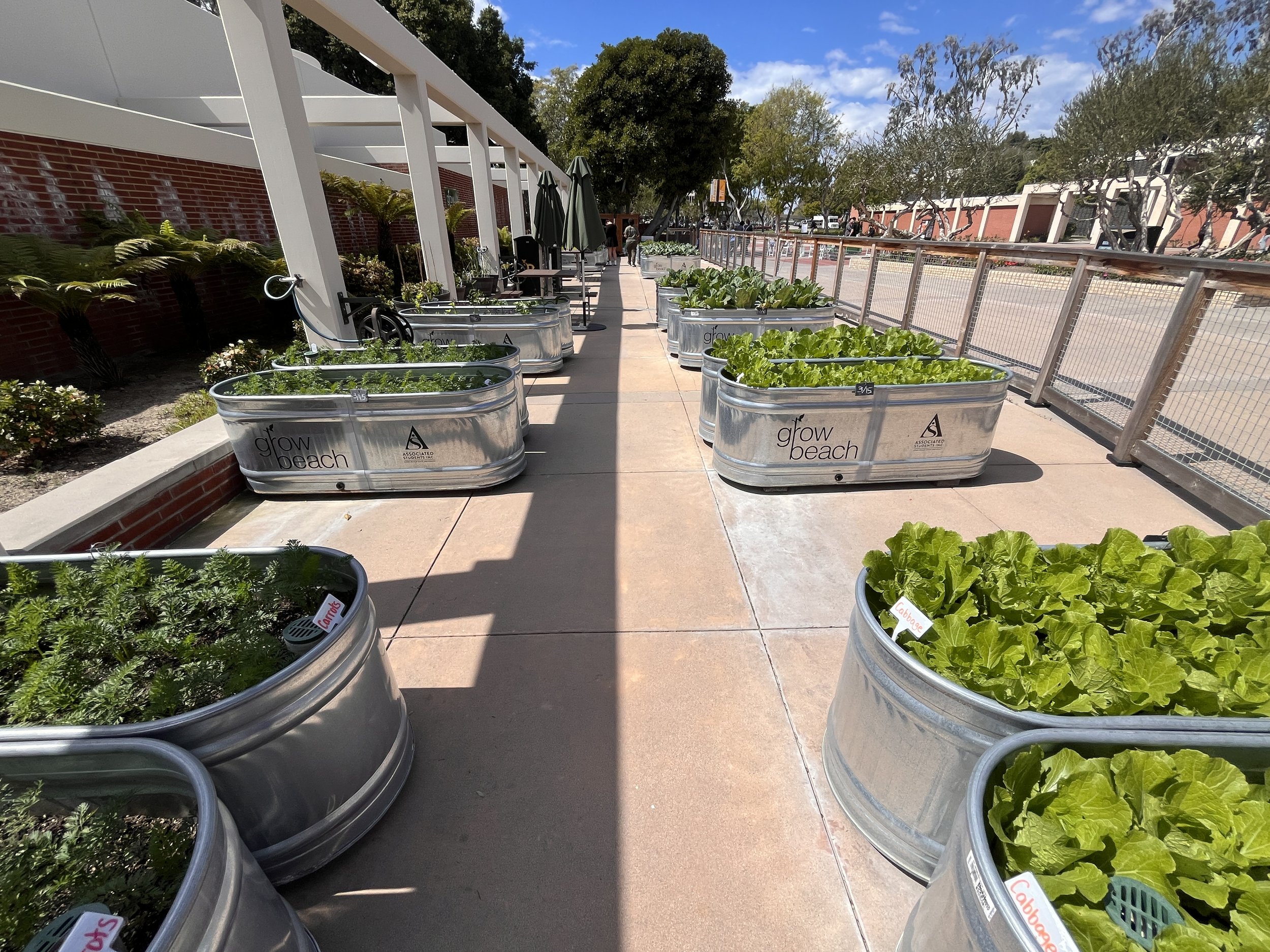Grow Beach Garden: Cultivation in CSULB’s backyard
At the heart of our campus is a hidden ecosystem teeming with life and educational opportunities called the Grow Beach Garden.
Here, with the tender care provided by passionate CSULB students, greenery sprouts and vibrant strawberry fruits ripen, showcasing a nurturing environment for plant-life cultivation.
Located near the Friendship Walk, this garden serves as a haven where students, supported by Sustain U—a team established under ASI with a mission to enhance the environmental quality of our campus—sow, cultivate and harvest abundant crops right in our own university's backyard.


The Grow Beach Garden, located on campus, is home to a variety of thriving plants and vegetables. Photos by Maureen Linzaga.
“I really like the aspect of taking care of something not my own, putting life into something else. And when taking care of these plants, I become very motherly, protective,” said Elena Gant, Sustain U Lead. “In nurturing these plants, I just want to see them grow and thrive.”
The garden receives seedlings from Armstrong Garden Centers, which they then transplant into larger planters to provide more soil for nutrients and root growth.
In the winter-to-spring rotation, various crops such as strawberries, celery, garlic and cilantro adorn the plots of the garden as the dedicated student staff are tasked with the upkeep, ensuring their growth.
Every weekday morning, even during winter and summer breaks, the team has a staff member or volunteer come in to check on the plants.
On Fridays, however, they dedicate more time to the garden, focusing on watering all the plants, applying organic herbicides and addressing any significant issues.
Mack Andersen, Sustainability Assistant at Sustain U, explained that this routine is enforced since they won't be available to tend to the garden over the weekend.
Once the plants have matured and are ready for harvest, the fresh fruits and vegetables are donated directly to the ASI Beach Pantry, demonstrating the garden's commitment to campus community nourishment.


Fruits and vegetables such as celery and strawberries thrive in the garden beds at Grow Beach Garden. Photos by Maureen Linzaga.
“We give them everything, that way, they can give it all back to the students and nothing goes to waste. And then if something is unable to be given back to students, they will return it to us to go into the compost bin, so it's all just one complete cycle,” Andersen said.
At the core of the garden’s purpose is the dedication to organic farming practices. Rejecting harmful chemicals and pesticides, the garden utilizes natural composts and research methods to promote plant health without compromising the environment and affecting pollinators.
Despite challenges like weather conditions and mildew issues common to South California, the team utilizes natural deterrents such as neem oil to combat invasive pests like hornworms, ladybugs and caterpillars.
A look into the environmentally friendly supplies that students use to maintain the Grow Beach Garden. Photo by Maureen Linzaga.
By adopting these practices, the garden not only maintains its mission and avoids the potential long-term impacts of chemicals on the CSULB campus environment, but also ensures the safety of the harvest for student consumption.
“We do our best to promote health and sustainability to our students here on campus, and by doing so, it's pretty enriching because we basically give that information as if you’re taking a sustainability class,” Gant added.
In addition to their informational sustainability workshops, the Grow Beach Garden and Sustain U also provide plenty of hands-on activities that involve students getting their own hands dirty.
In their most recent event “Seeds of Success”, students learned how to plant seeds and take care of them in small pots with the opportunity to take them home.
Students began by layering soil in a container, then added multiple seeds of their chosen plant, followed by another layer of soil. After watering, they encased it in a plastic Ziploc bag to create a “greenhouse” effect, which helps retain moisture and allows for better sunlight.
A student watering a small seedling. Photo by Maureen Linzaga.
Depending on which seeds they chose to plant, students could expect to see growth from their seedlings from four to 10 weeks, after which they can transplant the seedlings into bigger pots.
Because of these events that are readily available on campus, students can gain opportunities to start nurturing life even in between classes, despite being complete beginners to gardening.
The same was true for Gant at the beginning. In contrast to their aspirations for a career in animation and pre-production, Gant felt a profound enrichment in being outside, around nature and gaining gardening knowledge.
“When I first joined Sustain U, I didn't know jack diddly squat, you can say,” Gant said. “I came over here and I was like, ‘How much water do these need?’ And I would just spray a little bit, and then my teacher was like, ‘Dude, you're not gonna kill it!’ And he basically taught me the basics of how to take care of the garden.”
Sustain U outreach table promoting Grow Beach Garden and their mission of campus-wide nourishment and sustainability. Photo by Maureen Linzaga.
Now, Gant took on the lead role in the garden, giving them a physical break from working in the studio and further promoting a healthy work-life balance. They even started their own mini garden at their apartment complex.
Just like the education and information that they received as a beginner, Gant wants to pay it forward and do the same for other students through Sustain U.
Gant, like the rest of the team, believes that without information, one cannot fully understand the importance of sustainability and the ramifications of a lack of environmental awareness.
“We try to provide students reasons and activities and fun ways to educate [them], while also making sure [they] have tools to do it on [their] own time. And just like we plant, we also ‘plant’ the seeds of knowledge in [their] minds and help that foster and grow,” Gant said.



